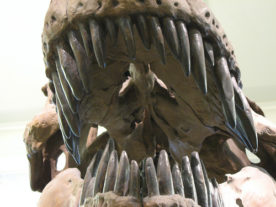
“There’s no place like home!” A NASA camera on the Deep Space Climate Observatory satellite has returned its first view of the entire sunlit side of Earth from one million miles away. (NASA)

A team works on the “Incredible Science Machine” on 7/16/15 at Detroit’s “Michigan Science Center”. This large chain reaction machine contained more than half a million objects, including about 200,000 dominoes and thousands of other common objects. Unfortunately the contraption didn’t quite set the record for “largest chain reaction machine” since several of its sections failed after being triggered on 7/18/15. (AP)

A dying star’s final moments are captured in this image from the NASA/ESA Hubble Space Telescope released on 7/27/15. As the star was dying it burst into a planetary nebula known as NGC 6565. (ESA/Hubble & NASA)

A robot took part in the groundbreaking ceremony for The College of New Jersey’s planned $75 million science, technology, engineering and mathematics complex in Ewing, New Jersey on 7/7/15. (AP)

This image of Pluto, released 7/24/15, was made by combining several images from two cameras on NASA’s New Horizons spacecraft when it was about 450,000 km from the dwarf planet. (NASA/JHUAPL/SwRI)

On 7/28/15, a team of scientists from the Smithsonian’s National Museum of Natural History and The Jamestown Rediscovery Foundation at Historic Jamestowne announced the identities of four men buried within Jamestown Virginia’s historic 1608 church. The remains have been identified as Rev. Robert Hunt, Capt. Gabriel Archer, Sir Ferdinando Wainman and Capt. William West, all high-status leaders who helped shape the future of America during the initial phase of the Jamestown colony. (James Di Loreto/Smithsonian Institution)

NASA’s NuSTAR telescope has captured high-energy X-rays coming from active regions across the sun. This image was created by combining observations from NuSTAR along with several other telescopes. The image was presented on 7/8/15 at the Royal Astronomical Society’s National Astronomy Meeting in Llandudno, Wales. (NASA/JPL-Caltech/GSFC/JAXA)

New Horizons Flight Controllers, at the Johns Hopkins University Applied Physics Laboratory in Laurel, Maryland, celebrate after they received confirmation that the NASA spacecraft had successfully completed its close flyby of Pluto on 7/14/15. (NASA)

Caltech led scientists discovered a powerful auroral display – seen in this artist’s conception – on a brown dwarf star some 20 light years away. The scientists said that these auroras also happen to be hundreds of thousands of times more powerful than any detected in our solar system. This discovery was outlined in the 7/30/15 edition of the journal “Nature”. (Chuck Carter and Gregg Hallinan/Caltech)

This photo, taken 7/20/15 through a pipe at the Baikonur Cosmodrome, shows a Soyuz-FG booster rocket with the space capsule Soyuz TMA-17M after being lifted onto its launch pad by three service towers. The spacecraft, launched on 7/22/15 carried a new crew to the International Space Station. (AP)

This composite image of stellar cluster NGC 1333 was created by combining observations made by NASA’s Chandra X-ray Observatory and Spitzer Space Telescope, along with optical data from the Digitized Sky Survey and the National Optical Astronomical Observatories’ Mayall 4-meter telescope near Tucson, Arizona. (NASA/CXC/JPL-Caltech/NOAO/DSS)
























The dying star’s final moments graphic could be a logo for: “random acts of kindness and senseless beauty.”